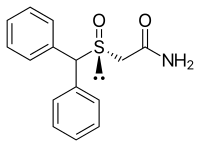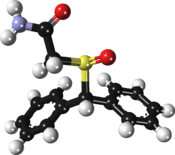Armodafinil
Armodafinil (trade name Nuvigil) is the enantiopure compound of the eugeroic modafinil (Provigil).[1] It consists of only the (R)-(−)-enantiomer of the racemic modafinil. Armodafinil is produced by the pharmaceutical company Cephalon Inc.[2] and was approved by the U.S. Food and Drug Administration (FDA) in June 2007.[3][4] In 2016, the FDA granted Mylan rights for the first generic version of Cephalon's Nuvigil to be marketed in the U.S.[5]
 | |
 | |
| Clinical data | |
|---|---|
| Trade names | Nuvigil, others |
| AHFS/Drugs.com | Monograph |
| MedlinePlus | a602016 |
| Pregnancy category |
|
| Dependence liability | Low |
| Routes of administration | Oral (tablets) |
| ATC code | |
| Legal status | |
| Legal status |
|
| Pharmacokinetic data | |
| Metabolism | Liver, including CYP3A4 and other pathways |
| Elimination half-life | 12–15 hours |
| Excretion | Urine (as metabolites) |
| Identifiers | |
IUPAC name
| |
| CAS Number | |
| PubChem CID | |
| ChemSpider | |
| UNII | |
| KEGG | |
| ChEBI | |
| ChEMBL | |
| ECHA InfoCard | 100.207.833 |
| Chemical and physical data | |
| Formula | C15H15NO2S |
| Molar mass | 273.35 g·mol−1 |
| 3D model (JSmol) | |
SMILES
| |
InChI
| |
| | |
Because armodafinil has a longer half-life than modafinil does, it may be more effective at improving wakefulness in patients with excessive daytime sleepiness.[6]
Medical uses
Armodafinil is currently FDA-approved to treat excessive daytime sleepiness associated with obstructive sleep apnea, narcolepsy, and shift work disorder.[2] It is commonly used off-label to treat attention deficit hyperactivity disorder, chronic fatigue syndrome, and major depressive disorder. It has been shown to improve vigilance in air traffic controllers.[7]
Sleep disorders
Armodafinil is approved by the U.S. FDA for the treatment of narcolepsy and shift work sleep disorder, and as an adjuvant therapy for obstructive sleep apnea.[8] For narcolepsy and obstructive sleep apnea, armodafinil is taken as a once daily 150 mg or 250 mg dose in the morning. For shift work sleep disorder, 150 mg of armodafinil are taken one hour prior to starting work. Slow dose titration is needed to mitigate some side effects.[8]
Investigational
Schizophrenia
In June 2010, it was revealed that a phase II study of armodafinil as an adjunctive therapy in adults with schizophrenia had failed to meet the primary endpoints, and the clinical program was subsequently terminated.[9] However, a study published later that year showed that schizophrenic patients treated with armodafinil showed fewer of the negative symptoms of schizophrenia.[10]
Adverse effects
In placebo-controlled studies, the most commonly observed side effects were headache, xerostomia (dry mouth), nausea, dizziness, and insomnia.
Possible side effects also include depression, anxiety, hallucinations, euphoria, extreme increase in activity and talking, anorexia, tremor, thirst, rash, suicidal thoughts, and aggression.
Symptoms of an overdose on armodafinil include trouble sleeping, restlessness, confusion, disorientation, feeling excited, mania, hallucinations, nausea, diarrhea, severely increased or decreased heart beat, chest pain, and increased blood pressure.[2][13][14]
Serious rashes can develop in rare cases, and require immediate medical attention due to the possibility of Steven's-Johnson Syndrome, or other hypersensitivities to armodafinil.[2]
Pharmacology
Pharmacodynamics
The mechanism of action of armodafinil is unknown. Armodafinil (R-(−)-modafinil) has pharmacological properties almost identical to those of modafinil (a mixture of R-(−)- and (S)-(+)-modafinil). The (R)- and (S)-enantiomers have similar pharmacological action in animals. Armodafinil has wake-promoting actions similar to sympathomimetic agents including amphetamine and methylphenidate, although its pharmacologic profile is not identical to that of the sympathomimetic amines. Armodafinil is an indirect dopamine receptor agonist; it binds in vitro to the dopamine transporter (DAT) and inhibits dopamine reuptake. For modafinil, this activity has been associated in vivo with increased extracellular dopamine levels. In genetically engineered mice lacking the dopamine transporter, modafinil lacked wake-promoting activity, suggesting that this activity was DAT-dependent. However, the wake-promoting effects of modafinil, unlike those of amphetamine, were not antagonized by the dopamine receptor antagonist haloperidol in rats. In addition, alpha-methyl-p-tyrosine, an inhibitor of dopamine synthesis, blocks the action of amphetamine but does not block locomotor activity induced by modafinil.
In addition to its wake-promoting effects and ability to increase locomotor activity in animals, according to Nuvigil prescribing information from manufacturer Cephalon, armodafinil produces psychoactive and euphoric effects, alterations in mood, perception, thinking, and feelings typical of other central nervous system (CNS) stimulants in humans.[2] Armodafinil, like racemic modafinil, may also possess reinforcing properties, as evidenced by its self-administration in monkeys previously trained to administer cocaine; armodafinil was also partially discriminated as stimulant-like. A Cephalon-founded study in which patients were administered modafinil, methylphenidate, and a placebo found that modafinil produces "psychoactive and euphoric effects and feelings consistent with [methylphenidate]."[2]
Pharmacokinetics
Armodafinil exhibits linear time-independent kinetics following single and multiple oral dose administration. Increase in systemic exposure is proportional over the dose range of 50–400 mg. No time-dependent change in kinetics was observed through 12 weeks of dosing. Apparent steady state for armodafinil was reached within 7 days of dosing. At steady state, the systemic exposure for armodafinil is 1.8 times the exposure observed after a single dose. The concentration-time profiles of the (R)-(−)-enantiomer following a single dose of 50 mg Nuvigil or 100 mg Provigil (modafinil being a 1:1 mixture of (R)-(−)- and (S)-(−)- enantiomers) are nearly superimposable. However, the Cmax of armodafinil at steady state was 37% higher following administration of 200 mg Nuvigil than the corresponding value of modafinil following administration of 200 mg Provigil due to the more rapid clearance of the (S)-(+)-enantiomer.
Absorption
Armodafinil is readily absorbed after oral administration. The absolute oral bioavailability was not determined due to the aqueous insolubility of armodafinil, which precluded intravenous administration. Peak plasma concentrations are attained at approximately 2 hours in the fasted state. Food effect on the overall bioavailability of armodafinil is considered minimal; however, time to reach peak concentration may be delayed 2–4 hours in the fed state. Since the delay in Tmax is also associated with elevated plasma concentration later in time, food can potentially affect the onset and time course of pharmacologic action of armodafinil.
Legal status
In Australia, and the United States, Armodafinil is considered to be a Schedule 4 prescription only medicine or prescription animal remedy.[15] Schedule 4 is defined as "Substances, the use or supply of which should be by or on the order of persons permitted by State or Territory legislation to prescribe and should be available from a pharmacist on prescription."
Romania
Armodafinil is not directly illegal in Romania, it is not scheduled as a narcotic, it is not included directly in the list of doping agents as modafinil is, but at laboratory testings it will show up as modafinil, being its enantiomer, and so will be prosecuted the same. Sanctions range from a warning to a 4.000 lei fine, and always confiscation of the substance.
Marketing
Brand names
Armodafinil is sold under a wide variety of brand names worldwide:
- Acronite (by Consern Pharma): India
- Armoda: ACI Pharmaceuticals (Symbiota), Bangladesh
- Armod: India (by Emcure Pharmaceuticals Ltd)
- Artvigil: India (by HAB Pharma)[16]
- Neoresotyl: Chile, Colombia
- Nuvigil: USA
- R-Modawake: India
- Waklert: India (by Sun Pharma)[17]
- Modavital: El Salvador (Farmaceutica INHOSPI (by Laboratorios Marceli)
See also
- Adrafinil
- CRL-40,940
- CRL-40,941
- Fluorenol
- Modafinil
References
- Engber TM, Koury EJ, Dennis SA, Miller MS, Contreras PC, Bhat RV (January 1998). "Differential patterns of regional c-Fos induction in the rat brain by amphetamine and the novel wakefulness-promoting agent modafinil". Neurosci. Lett. 241 (2–3): 95–8. doi:10.1016/s0304-3940(97)00962-2. PMID 9507929.
- "Archived copy" (PDF). Archived from the original (PDF) on 2018-01-07. Retrieved 2013-11-23.CS1 maint: archived copy as title (link)
- "CDER Drug and Biologic Approvals for Calendar Year 2007" (PDF). Retrieved January 21, 2008.
- "Search results from the "OB_Rx" table for query on "021875."", Orange Book, U.S. Food and Drug Administration, March 2012, retrieved April 30, 2012
- "Mylan Launches First Generic of Nuvigil® Tablets". MediaRoom. Retrieved February 9, 2017.
- Darwish, M.; Kirby, M.; Hellriegel, E. T.; Robertson Jr, P. (2009). "Armodafinil and Modafinil Have Substantially Different Pharmacokinetic Profiles Despite Having the Same Terminal Half-Lives". Clinical Drug Investigation. 29 (9): 613–623. doi:10.2165/11315280-000000000-00000. PMID 19663523.
- Phillips, J. B.; Simmons, R. G.; Arnold, R. D. (2011). "A single dose of armodafinil significantly promotes vigilance 11 hours post-dose". Military medicine. 176 (7): 833–839. PMID 22128728.
- RXList-nuvigil
- "Cephalon Provides Clinical Update on Phase II Study of NUVIGIL as an Adjunctive Therapy in Adults with Schizophrenia". Retrieved August 21, 2011.
- Kane, J. M.; d'Souza, D. C.; Patkar, A. A.; Youakim, J. M.; Tiller, J. M.; Yang, R.; Keefe, R. S. E. (2010). "Armodafinil as Adjunctive Therapy in Adults with Cognitive Deficits Associated with Schizophrenia". The Journal of Clinical Psychiatry. 71 (11): 1475–1481. doi:10.4088/JCP.09m05950gry. PMID 20816042.
- Pollack, Andrew (January 6, 2010). "A Drug's Second Act: Battling Jet Lag". The New York Times. Retrieved March 30, 2010.
- Pollack, Andrew (March 29, 2010). "Regulators Reject a Drug Maker's Plan to Use Its Alertness Pill to Overcome Jet Lag". The New York Times. Retrieved March 30, 2010.
- "Nuvigil (Armodafinil): Side Effects, Interactions, Warning, Dosage & Uses".
- "Archived copy". Archived from the original on 2016-03-03. Retrieved 2014-10-14.CS1 maint: archived copy as title (link)
- Poisons Standard March 2018 https://www.legislation.gov.au/Details/F2018L00168
- https://modafinil.org/artvigil/
- https://modafinil.org/waklert/